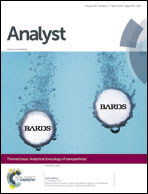Magnetic nanoparticles coated with different shells for biorecognition: high specific binding capacity
Abstract
Modifying the surfaces of magnetic nanoparticles (MNPs) by the covalent attachment of biomolecules will enable their application as media for magnetically-assisted bioseparations. In this paper, we reported both the activity and specific binding capacity of ferritin antibodies on core–shell MNPs. The antibodies were covalently attached on silica-, silver- and polydopamine-coated MNPs by different methods. Anti-ferritin was bound onto the silica- or silver-coated MNPs by conventional methods using 3-aminopropyltriethoxysilane (APTES) or 11-mercaptoundecanoic acid (MUA), which was followed by activation of carboxyl groups by EDC/NHS. However with anti-ferritin immobilized onto the Fe3O4 nanoparticles modified with polydopamine, an in situ coating formed through the adhesive proteins. In addition, a great deal of anti-ferritin biomolecules covalently attached onto the MNPs. According to our results, the amounts of bound anti-ferritin onto the silica-, silver- and PDA-coated MNPs were 70, 75 and 95 μg anti-ferritin per mg MNP, respectively. In the experiments, polydopamine (PDA)-coated MNPs showed faster adsorption, more significant selectivity and a larger binding capacity than the others. Also, the equilibrium dissociation constants of the antigen–antibody complexes were determined on the anti-ferritin-immobilized MNPs. Silica-, PDA- and silver-coated MNPs had Kd values of 5.45 × 10−7, 2.12 × 10−7 and 3.91 × 10−8 mol L−1, respectively. Based on these results, the affinity of the anti-ferritin for ferritin on the PDA-coated MNPs was approximately 10-fold higher than that on the silica- and silver-coated MNPs. In addition, among the anti-ferritin-immobilized silica-, silver- and PDA-coated MNPs, the PDA-coated MNPs showed the highest antigen selectivity values. As a result, anti-ferritin-immobilized PDA-coated MNPs represented a higher activity and stronger affinity for the specific antigen than the others.


 Please wait while we load your content...
Please wait while we load your content...